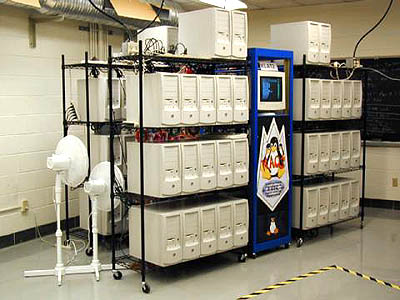Sake bracht ons een linkje naar het Kentucky Linux Athlon Testbed 2, een low-cost Beowulf cluster met 64 Athlon 700 computers. De nodes beschikken elk over vier 100Mbit netwerkkaarten en zijn via negen 32-poorts switches aan elkaar geknoopt. Hierdoor staan alle bakken in direkt contact met elkaar ('flat neighborhood' netwerk topologie), waardoor de beschikbare netwerk bandbreedte optimaal benut kan worden en netwerk latencies zo laag mogelijk zijn:
May 2000, Lexington, Kentucky: Researchers at the University of Kentucky have constructed and demonstrated an innovative new, scalable, parallel supercomputer that achieves application performance of more than 1 billion floating point operations per second (GFLOPS) for every $650 spent on building the machine. The approach used to design and build this machine makes it cost-effective for solving a wide range of problems, from drug design using computational chemistry to design of quieter printers using computational fluid dynamics (CFD). Thus, this breakthrough is not only a milestone, but also will enable many more scientists and engineers to use computational models.Less than a decade ago, a 1GFLOPS supercomputer cost millions of dollars; the latest traditional supercomputers are closer to $10,000 per GFLOPS. "Beowulfs," clusters of PCs configured to work together as a single supercomputer, have recently brought that cost down to about $3,000 per GFLOPS. KLAT2, Kentucky Linux Athlon Testbed 2 (http://aggregate.org/KLAT2/), improves upon the Beowulf concept by using a variety of new technologies to make more efficient use of commodity PC hardware -- thus breaking the $1,000 per GFLOPS barrier.
To function as a supercomputer, the PCs within a cluster need to be interconnected by a high-performance network. Instead of expensive gigabit network hardware, KLAT2's network uses lots of cheap 100Mb/s Ethernet hardware in a new configuration called a "Flat Neighborhood" network.
Using conventional software, PC processors are approaching the speed of the processors in traditional supercomputers. KLAT2's software takes advantage of special features of the AMD Athlon processor to dramatically accelerate some computations. 3DNow! 32-bit vector floating point allows KLAT2's sixty-four 700MHz Athlons to achieve more than 64GFLOPS while solving a system of 40,960 equations -- slightly faster than the 64-bit arithmetic performance of the machine ranked 150th in Jack Dongarra's list of the 500 fastest supercomputers in the world (http://www.top500.org/).
KLAT2's Athlon processors, which have a current retail value of about $13,000, were donated by AMD. The network cost just over $8,000. Everything else to build the cluster was about $20,000. That cost includes a few unusual items, such as pizza and soda for the over 30 Electrical Engineering and Computer Science students who volunteered to help build the system.
From the creation of the first Linux PC cluster in February 1994 to the construction of KLAT2, Hank Dietz and his students have continued to improve cluster performance by making compilers, hardware architecture, and operating system work together more efficiently. At the University of Kentucky, as Professor of Electrical Engineering and James F. Hardymon Chair in Networking, Dietz's goal is to use the new technologies to make inexpensive "Personalized Turnkey Superclusters (PeTS)" that will allow scientists and engineers to easily solve their most important computational problems.
 |

